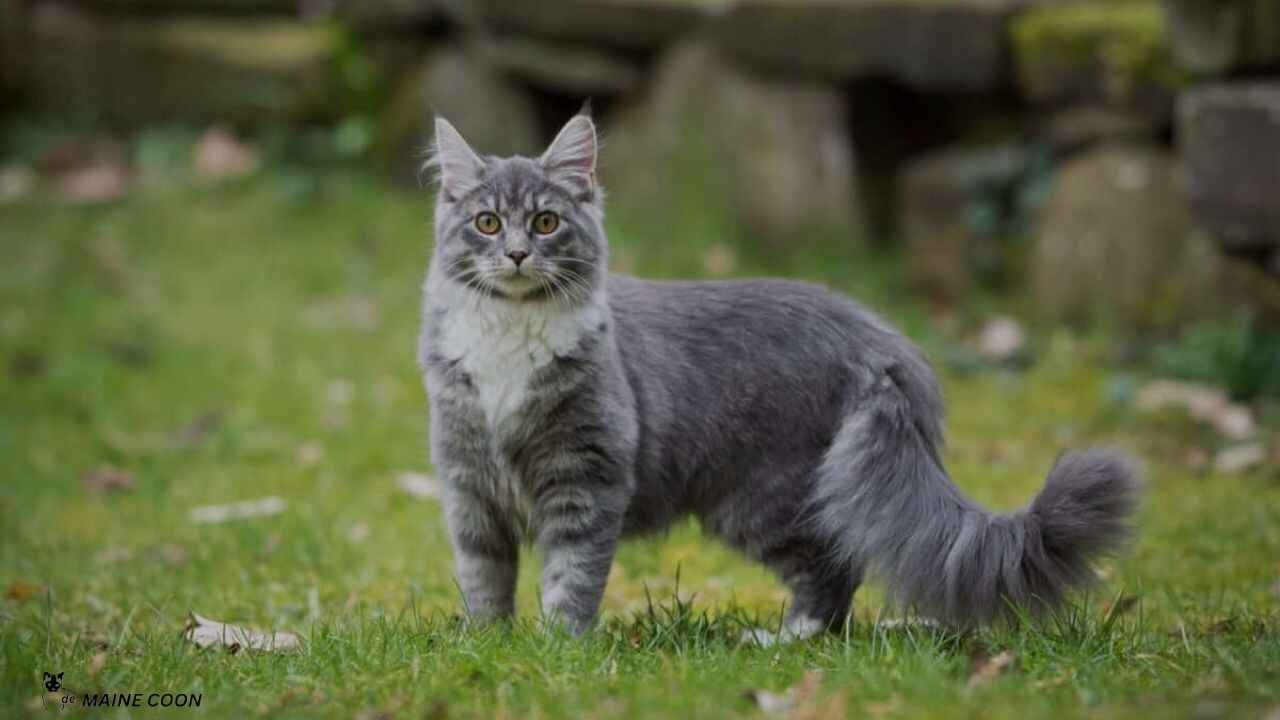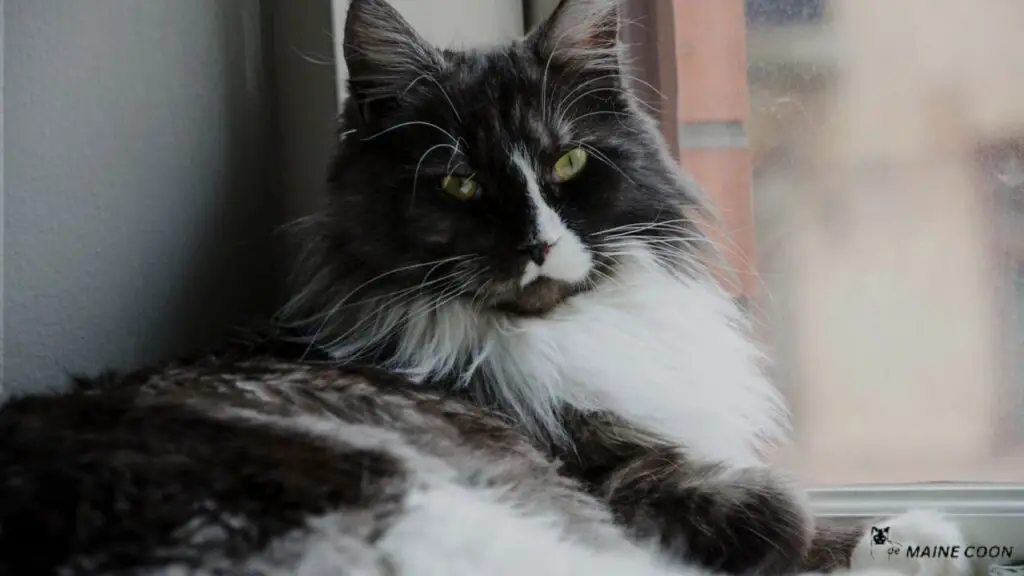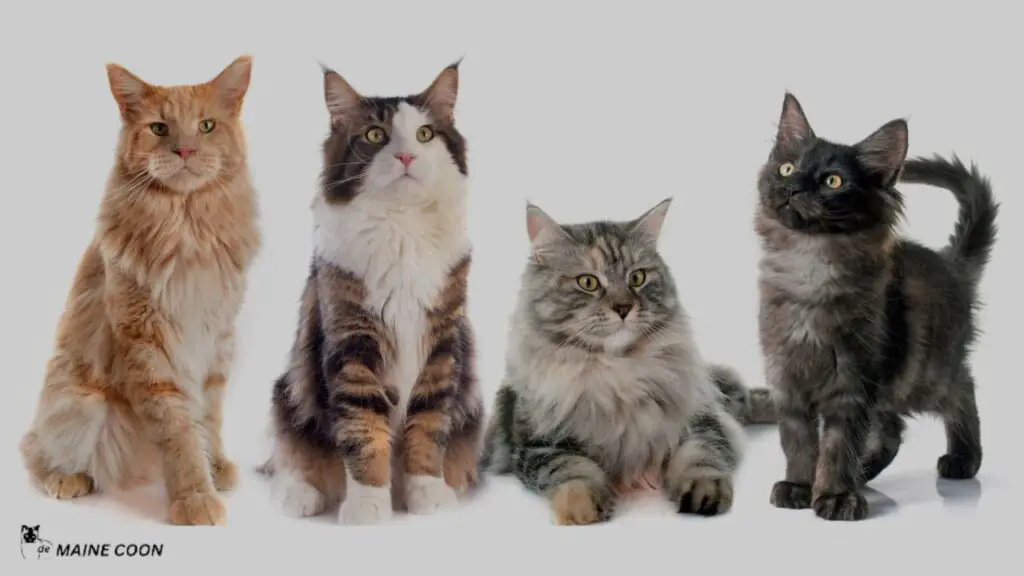Maine Coon Tail: Comprehensive Guide

Maine Coon cats are known for their relatively elongated tails in comparison to other cat breeds, but what is the reason behind the distinctive length of their tail?
Certainly, the Maine Coon’s bushy and furry tail is gorgeous, but its purpose extends beyond more aesthetics!
Maine Coon cats have long tails adorned with thick, long fur. The size of a cat’s tail is determined by the length of its body. As the largest domesticated cat breed in the world, Maine Coon cats possess tails proportionate to their large size so that they can balance properly. Besides, their extended, lush tails are also useful to protect against cold weather.
Beyond providing balance and warmth, a Maine Coon tail serves numerous functions, and some might be unexpectedly surprising.
Continue reading to find out how your Maine Coon tail can be a crucial indicator of your cat’s emotions.
Why Does the Maine Coon Tail Get So Long?
If you’re fascinated by the magnificent Maine Coons, you’re certainly not alone. These cat beauties, known for their majestic presence and notable look, have captivated feline lovers far and wide.
Maine Coon cats are renowned for their long, luxurious tails, and it’s not merely for aesthetics! Their oversized tails play a key role in maintaining warmth, assisting with balance, and serving as a mode of communication.
1. For Keeping Warm
Maine Coons come from the cold northeastern United States, where winters can be harsh and chilly. Their big, bushy tails act like natural scarves. When curled up, these cats frequently wrap their tails and bodies covering their paws and faces. This assists in keeping them warm and shields their sensitive areas from the biting cold.
2. Balance
Any cat lover would agree that felines have an extraordinary sense of balance, and Maine Coon cats are no exception. Maine Coon tail plays a key role in enhancing this ability. While leaping, climbing, or navigating narrow paths, the Maine Coon tail acts as a counterweight, assisting the cat in maintaining stability and balance—an important acrobatic tool!
3. Communication
In the cat’s world, their tail functions as a mood indicator. Similarly, a Maine Coon tail serves as an essential tool for communication.
Maine Coon tail postures and movements can express several feelings, from happiness and satisfaction to fear and aggression. Understanding these signals can help cat owners in assessing their cat’s mood and responding accordingly.
Maine Coon Tail Features
The Maine Coon cat tail is truly marvelous, garnering admiration for its exceptional length, thickness, texture, and more.
Length
The Maine Coon tail’s length is a distinctive hallmark feature of the breed, averaging around 11 to 18 inches. Remarkably, certain Maine Coon tails may even be longer.
The length of the Maine Coon tail frequently equals the distance from its nose to the base of the tail, and some even extend beyond their body length! This magnificent size contributes significantly to their overall amazing appearance.
Thickness
Maine Coon tails are not only long, but they also boast exceptional thickness and fluffiness. The high volume of their tail is due to the dense and bushy double-layer coat they possess. The undercoat is soft and fine, providing insulation, while the water-repellent outer coat contributes to the substantial fluffy appearance of the tail.
Texture
Despite its shaggy appearance, a healthy Maine Coon tail’s fur remains absolutely silky to the touch. Daily grooming is essential for maintaining the Maine Coon cat tail fur smooth and avoiding matting.
Tip
The tail generally ends in a tapering point, often accentuated by longer fur that imparts a brush-like look, making it extra pretty.
Color
The Maine Coon cat’s tail color will match the rest of its coat. They come in over 70 colors and patterns, including black, white, red, blue, grey, cream, silver, black and white, smoke, black smoke, blue smoke, tortoiseshell, bicolor, shaded, shaded silver, solid, calico, tabby, tabbies, and more.
Tabby Maine Coon tails often display ring patterns, resembling those found on raccoon tails. These alternating bands of color, transitioning from lighter to darker shades based on the cat’s primary color, contribute to the urban legend that Maine Coons are a raccoon hybrid.
Longest Cat Tail
Although all Maine Coon cats have long tails, some go beyond the average length. Cygnus, a Maine Coon, once held the record for the longest cat tail. His tail measured a magnificent 44.66 cm (17.58 inches). This remarkable length stands as evidence of the breed’s capacity to grow exceptionally lengthy tails. Sadly, he met a tragic end in a house fire in 2021.
Maine Coon Kitten Tail
Maine Coon kitten tails are initially small at birth and slowly grow as they mature. The fluffy Maine Coon kitten tail begins to fill out and lengthen alongside their growth, achieving their full size by around three years old.
Watching the growth of a Maine Coon kitten and the development of its signature tail is a fascination for numerous owners, myself included.
See Also: Maine Coon size comparison to dogs.
Maine Coon Tail Language

The tail typically will speak louder than the vocal powers. Every movement of the tail is deliberate, driven by a particular reason and purpose.
- Straight-Up Tail: When your cat’s tail is straight up, it’s usually the biggest sign of their happiness and contentment.
- Straight Down Tail: Tail straight down is typically a sign that the cat is feeling nervous and scared. The cat perceives something in its surroundings as a potential danger.
- Raised and Vibrating Tail: When the tail is raised and vibrating, it signals that the cat is happy to see you and be around you. Some individuals associate this behavior with how the cat appears when it is spraying.
- Tail Tucked Between Legs: When a cat is anxious, it instinctively tucks its tail between its hind legs.
- Slow Wag Tail: A slow wagging of the tail indicates that the cat is accessing its surroundings. It’s recommended to walk away and give the cat time to calm down.
- Rapidly Wagging Tail: A rapid wagging tail signals that your cat is agitated about something. It’s recommended to refrain from trying to pet the cat during this time. Leave it alone and allow it time to calm down.
- Parallel Tail: There is a mission on your cat’s mind, showing a curious interest in something it’s observing and wanting to know more about it.
- Straight Up Tail with A Subtle Bend: The cat is optimistic about being around you, feeling the potential for a buddy connection.
- Tall and Bushy Tail: This is a clear sign of anger. The cat is either mad at you or reacting to a specific incident in its surroundings. Exercise caution and beware. Allow the cat some time to settle down.
You may also be interested in: Maine Coon behavior problems & their solutions.
Do All Maine Coon Cats Have Fluffy Tails
While all purebred Maine Coon cats develop dense, fluffy tails as adults, do Maine Coon kittens have fluffy tails?
Maine Coon kittens first have thin, non-bushy tails. In fact, their tails don’t become fluffy until they’re around the age of 4 to 5 months.
Maine Coon Cat Tail Not Fluffy
Maine Coon cats are expected to have long, fluffy tails. If your Maine Coon’s tail lacks fluffiness, it may indicate a problem with your cat.
Here’s a list of reasons why your Maine Coon tail may not be fluffy:
1. It’s A Mixed Breed
If your Maine Coon cat tail lacks bushiness and thickness, it might suggest that your feline is not purebred. The characteristic long, fluffy fur in a Maine Coon tail is a hallmark of the breed. However, if you know for a fact that your cat is a purebred Maine Coon, a non-fluffy tail could be due to medical reasons.
See Also: Charming & Popular Maine Coon mix breeds.
2. It’s Yet Young
Maine Coon kitten tails are not fluffy when they are born. Generally, their tails start to develop fluffiness around 4 to 5 months of age.
3. Poor Nutrition
If a Maine Coon tail appears less fluffy than normal, it may indicate a general health problem or poor nutrition. Proper grooming, a balanced diet, and regular veterinary check-ups can assist in keeping the tail fluff and overall healthy.
4. Maine Coon Tail Thinning
If your purebred Maine Coon has a non-fluffy tail, it is probably due to the Maine Coon tail hair loss. The thinning of your cat’s fur could be caused by a variety of reasons.
Below, we’ve listed a few of the most usual Maine Coon tail thinning factors:
- Stress: When cats experience stress, they may begin grooming themselves an excessive amount or even resort to chewing on their fur, leading to unnatural amounts of hair loss. Some usual causes of stress in cats include moving, the introduction of a new family member or pet, or other big life changes.
- Allergies: Allergies can be a factor in your Maine Coon to start losing fur. Seasonal allergies to pollen, dust, or mold could be potential triggers, or your Maine may be suffering from food allergies.
- Underlying Illness: If your Maine Coon is experiencing fur loss on the tail, it might be due to an underlying illness like diabetes or cancer. If you observe any other worrying symptoms like lethargy or weight loss, make sure to prompt veterinary attention for your cat.
- Parasites: Infestations from parasites like mites, ringworms, fleas, or lice can cause hair loss in your feline. Examine your cat’s skin for any indication of bugs, irritation, or inflammation. Seek prompt veterinary attention for treatment straight away, if you suspect any parasitic infections.
See Also: Are Maine Coon Hypoallergenic.
Maine Coon Tail Care
Following are some tips for Maine Coon tail care:
Diet:
A nutritious diet plays an important role in managing your Maine Coon’s health, involving their tail.
Carbohydrates supply energy for exercise and play, on the other hand, fatty acids maintain their fur shiny and in excellent condition.
High-quality protein-packed dry food should be an important component of their dietary requirements. Chicken, Mice, fish, and rabbits are the source of protein.
Grooming:
Maine Coon’s tail requires regular brushing to avoid tangles. Brushing your Maine Coon’s hair 2-3 times a week is ideal. This keeps their coat neat and healthy.
Tangles in Maine Coon’s hair can cause psychological distress to your cat, so regular grooming is necessary.
Hydration:
Maine Coons really like water, make sure they drink water to stay hydrated. Use a water bowl or cat water fountain to promote drinking.
Health Check-ups:
Visit your vet for check-ups. Seek professional advice if your Maine Coon’s tail does not appear more bulky than usual. This shows health problems or an unhealthy diet.
Always keep in mind that every Maine Coon is different, make sure to pay attention to your cat’s needs. With full care, your Maine Coon’s tail always remains healthy.
What is Hypermobile Cat Tail?
A hypermobile cat’s tail is far more flexible in comparison to typical cats. Cats with hypermobile tails can easily curl them over their backs, and may even be able to touch their ears with their tails! Numerous hypermobile cats prefer to rest their tails over their backs because they find it more comfortable.
Maine Coon Stud Tail
An oily tail in a Maine Coon is generally the result of a mild skin condition known as stud tail. Although Maine Coon stud tail is more usual in unneutered males, it can occur in both fixed and unfixed males and females.
The Stud tail is caused by clogged pores on a cat’s back, resulting in a greasy buildup at the base of the tail. Once a vet has diagnosed a cat with a stud tail, the recommended treatment might involve washing the affected area and applying topical ointments to the affected skin.
Tailless Maine Coon
Although tails play a key role in a cat’s anatomy, they can also survive without their tails. Some cats might require to have their tails amputated due to injury, and some cats are also born without tails. If your Maine Coon cat was born without a tail, it is probably a mixed breed and has Manx Cat ancestry or has a rare gene that causes taillessness.
Norwegian Forest Cat Tail Vs Maine Coon Tail
Both Maine Coons and Norwegian Forest Cats possess bushy, lengthy tails. Nevertheless, the typical length of the Maine Coon’s tail is even longer, and it also features a thicker base.
See Also: Maine Coon Norwegian Forest Cat mix.
Final Thoughts
Maine Coon cats can have very long tails, showcasing a variety of colors and patterns that extend to about three-quarters of their body length. If you have the opportunity to examine a Maine Coon tail, you’ll notice that it is covered in long fur from head to tip, with the last few inches completely covered.
Like all cats, a seriously wagging tail signals annoyance, irrespective of their dog-like personality. Being held upright is commonly a sign of contentment, while a Maine Coon expresses its mood through its tail.
You may also be interested in: Do Maine Coons get along with dogs.
Frequently Asked Questions
Do Maine Coons shed a lot of hair?
Maine Coon can shed a lot of hair, particularly during the summer months, so regular grooming is required to remove the undercoat fur. Their fur is long and double coated so expect fur shedding in warmer climates. Be watchful of hairballs, especially in cats with high fur-shedding tendencies.
Do Maine Coons have ringed tails?
Maine Coon cats were named for their resemblance to raccoons, frequently featuring brown tabby coats and tails adorned with furry rings.
Do Maine Coon cats like to be held?
Some Maine Coon cats enjoy being held, while others don’t. It’s not a trait of the breed but rather an individual cat’s preference. Since Maine Coon cats are loyal, social, and friendly, numerous like being picked up and held. Just be gentle and don’t hold them too tightly or restrict their ability to get down; otherwise, they will be put off the experience.
Is it essential to brush my Maine Coons tail?
There are two layers of Maine Coon’s coat: an undercoat and an overcoat. Brush your Maine Coon twice for their appearance. First, use a metal comb. Brush from head to tail for good results.




